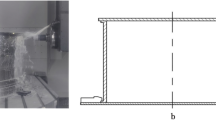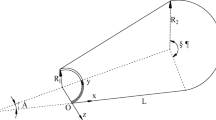Abstract
Camshaft usually vibrates violently in swing grinding due to its complex contour, and the dam** performance of device directly affects the surface quality of camshaft. Aiming at the problem that the traditional vibration dam** device has been forced by installation constraints and it is difficult to control the vibration frequency in a specific range, the vibration dam** structure for camshaft journal and grinder tailstock based on the local resonance bandgap (LRBG) mechanism is carried out in this paper, respectively. On the basis of the vibration data obtained from the experimental analysis, the corresponding finite element model is established, the resonant bandgap characteristics and the bandgap influence rules of each system structure are discussed. Comparing the dam** performance of the system before and after vibration reduction based on the optimized vibration reduction model obtained from the influence rules, the vibration reduction effect of the local resonance (LR) structure designed in this paper is very significant. Compared with the homogeneous structure, the dam** performance at the journal and tailstock is improved by 31.6% and 89.3% respectively. The design achieves the goal that controlling large wavelength with small size, which provides a good application prospect for the local resonance phononic crystals (LRPCs) in the vibration reduction field of camshaft swing grinding.










Similar content being viewed by others
REFERENCES
M. Y. Wang, Y. T. Choy, C. W. Wan, and A. S. Zhao, “Wide band-gaps in flexural periodic beams with separated force and moment resonators,” J. Vib. Acoust. 137 (6), 064504 (2015). https://doi.org/10.1115/1.4031519
P. F. Guo, Z. Q. Lang, and Z. K. Peng, “Analysis and design of the force and displacement transmissibility of nonlinear viscous damper, based vibration isolation systems,” Nonlin. Dyn. 67 (4), 2671–2687 (2012). https://doi.org/10.1007/s11071-011-0180-6
D. Qu, X. D. Liu, G. T. Liu, et al., “Analysis of vibration isolation performance of parallel air spring system for precision equipment transportation,” Meas. Contr. 52 (3–4), 291–302 (2019). https://doi.org/10.1177/0020294019836122
S. Mohammadi, S. Hatama, and A. Khodayari, “Modeling of a hybrid semi-active/passive vibration control technique,” J. Vib. Contr. 21(1), 21–28 (2015). https://doi.org/10.1177/1077546313479633
R. K. Singh, R. Kant, S. S. Pandey, et al., “Passive vibration dam** using polymer pads with microchannel arrays,” J. Microelectromech. Syst. 22(3), 695–707 (2013). https://doi.org/10.1109/JMEMS.2013.2241392
Y. Zhang, Z. B. Chen, and Y. H. Jia, “A hybrid vibration isolator: Design, control, and experiments,” Proc. Inst. Mech. Eng. C: J. Mech. Eng. Sci. 230 (17), 2982–2995 (2016). https://doi.org/10.1177/0954406215604335
Y. Zhang, Y. Zang, M. Li, et al., “Active-passive integrated vibration control for control moment gyros and its application to satellites,” J. Sound Vib. 394, 1–14 (2017). https://doi.org/10.1016/j.jsv.2017.01.002
M. M. Sigalas and E. N. Economou, “Elastic and acoustic wave band structure,” J. Sound Vib. 158 (2), 377–382 (1992). https://doi.org/10.1016/0022-460X(92)90059-7
M. S. Kushwaha, P. Halevi, L. Dobrzynski, and B. Djafari-Rouhani, “Acoustic band structure of periodic elastic composites,” Phys. Rev. Lett. 71 (13), 2022–2025 (1993). https://doi.org/10.1103/PhysRevLett.71.2022
Y. F. Zhang, D. L. Yu, and J. H. Wen, “Study on the band gaps of phononic crystal pipes with alternating materials in the radial and axial directions,” Extr. Mech. Lett. 12, 2– (2017). https://doi.org/10.1016/j.eml.2016.10.005
C. X. Cai, C. Han, J. F. Wu, et al., “Tuning method of phononic band gaps of locally resonant pentamode metamaterials,” J. Phys. D 52 (4), 045601 (2019). https://doi.org/10.1088/1361-6463/aaebdc
L. Fan, Y. He, X. Zhao, and X. A. Zhao, “Subwavelength and broadband tunable topological interface state for flexural wave in one-dimensional locally resonant phononic crystal,” J. Appl. Phys. 127 (23), 235106 (2020). https://doi.org/10.1063/5.0001548
H. **ang, X. F. Ma, and J. W. **ang, “Optimization for a locally resonant phononic crystal of square spiral with circle inside,” IEEE Access 7, 145988–145995 (2019). https://doi.org/10.1109/ACCESS.2019.2946085
X. L. Zhou and L. Q. Wang, “Opening complete band gaps in two dimensional locally resonant phononic crystals,” J. Phys. Chem. Solids 116, 174–179 (2018). https://doi.org/10.1016/j.jpcs.2018.01.025
Z. Y. Liu, X. X. Zhang, Y. W. Mao, et al., “Locally resonant sonic materials,” Science 289 (5485), 1734–1736 (2000). https://doi.org/10.1126/science.289.5485.1734
S. B. Li, Y. H. Dou, T. N. Chen, et al., “Designing a broad locally-resonant bandgap in a phononic crystals,” Phys. Lett. A 383 (12), 1371–1377 (2019). https://doi.org/10.1016/j.physleta.2019.01.061
S. G. Zuo, H. D. Huang, X. D. Wu, et al., “Low-frequency band gap of locally resonant phononic crystals with a dual-base plate,” J. Acoust. Soc. Am. 143 (3), 1326–1332 (2018). https://doi.org/10.1121/1.5025041
X. D. Wu, M. H. Zhang, S. G. Zuo, et al., “An investigation on interior noise reduction using 2D locally resonant phononic crystal with point defect on car ceiling,” J. Vib. Contr. 25 (2), 386–396 (2019). https://doi.org/10.1177/1077546318782242
C. Y. Zhao, J. Y. Zheng, T. Sang, et al., “Computational analysis of phononic crystal vibration isolators via FEM coupled with the acoustic black hole effect to attenuate railway-induced vibration,” Constr. Build. Mater. 283, 122802 (2021). https://doi.org/10.1016/j.conbuildmat.2021.122802
Y. D. Ruan, X. Liang, X. Y. Hua, et al., “Isolating low-frequency vibration from power systems on a ship using spiral phononic crystals,” Ocean Eng. 225, 108804 (2021). https://doi.org/10.1016/j.oceaneng.2021.108804
C. M. Chen, Z. F. Guo, S. T. Liu, et al. “Effect of cavity structure on acoustic characteristics of phononic crystals based on double-layer plates,” Crystals 10 (11), 995 (2020). https://doi.org/10.3390/cryst10110995
C. **ong, Q. S. Han, Q. G. Li and B. Y. Peng. “Research on non-circular grinding force model of CAM grinding,” Mech. Eng. Auto. 5, 12 (2015).
G. Wang, L. H. Shao, Y. Z. Liu, and J. H. Wen. “Accurate evaluation of lowest band gaps in ternary locally resonant phononic crystals,” Chinese Phys. 15 (8), 1843–1848 (2006). https://doi.org/10.1088/1009-1963/15/8/036
Funding
This study was supported by General project of natural science research of Institutions of Higher Education of Jiangsu Province of China (21KJB510016) and the National Natural Science Foundation of China (no. 62203193).
Author information
Authors and Affiliations
Corresponding author
About this article
Cite this article
Shi, X.N., Liu, H.Y., Zhao, L. et al. Research on the Vibration Reduction Design of Camshaft Swing Grinding Based on Local Resonance Mechanism. Mech. Solids 58, 922–938 (2023). https://doi.org/10.3103/S0025654423700103
Received:
Revised:
Accepted:
Published:
Issue Date:
DOI: https://doi.org/10.3103/S0025654423700103




